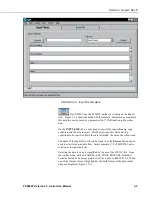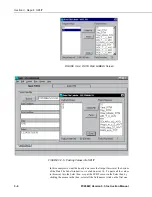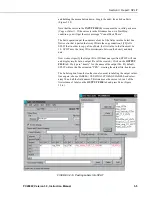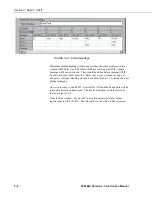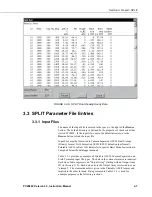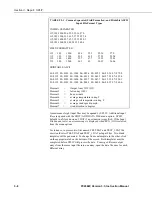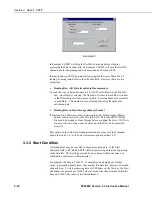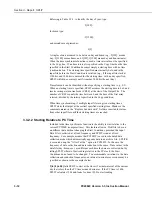
PC208W, Version 3.3, Instruction Manual
3-1
Section 3. Report: SPLIT
3.1 Overview
SPLIT is a tool to aid the use and analysis of data collected with Campbell
Scientific dataloggers. Its name comes from its function of splitting specific
data from a larger data file. The most common application, as shown in
Section 3.2, Getting Started, is to separate data collected on a particular
interval from a data file containing data output at several different intervals.
In addition to simply splitting a data array collected at one interval from all the
data collected by a datalogger, SPLIT applications include: data selection
based on time or conditions, statistics, calculations, file reformatting, data
quality checking (limit testing), table generation with report and column
headings, and time synchronizing and merging of up to eight files.
Input Files (maximum of eight) are read by SPLIT, specific operations are
performed on the data, and the results are output to a single Output File or print
out. SPLIT creates a parameter file (filename.PAR) that defines which data
files are read, what operations are performed on the data set, and where the
final results will be saved. The parameter file may be saved and used again.
Input Files (Section 3.3.1) must be formatted in Printable ASCII, Comma
Separated ASCII, Field Formatted ASCII, Final Storage (Binary) Format, or
Raw A/D data.
Output files generated by SPLIT are Field Formatted (default), Comma
Separated ASCII, or Printable ASCII.
SPLIT lends itself to experimentation. The processed data are displayed on the
screen, giving immediate feedback as to the effect of changes or new entries to
the parameter file. The Input File is not modified by SPLIT.
3.2 Getting Started
The most common use of SPLIT is to separate data collected on a particular
interval from a data file containing data output at several different intervals.
In the following example, hourly data are split from a data set that contains
both hourly and daily data. The data were collected from Weather Station 1, a
CR10X. The station was named WS1 when telecommunications were set up
so the data are stored in the file WS1.dat. The CR10X was loaded with a
program created by EDLOG named WS1.dld.
The hourly data, array 10, and the daily data, array 20, are intermixed in the
data file (Figure 3.2-1)
Summary of Contents for PC208W
Page 2: ...This is a blank page...
Page 4: ......
Page 58: ...Section 2 Program EDLOG 2 18 PC208W Version 3 3 Instruction Manual This is a blank page...
Page 98: ...Section 3 Report SPLIT 3 40 PC208W Version 3 3 Instruction Manual This is a blank page...
Page 126: ...Section 6 Program Conversion 6 4 PC208W Version 3 3 Instruction Manual This is a blank page...
Page 156: ...This is a blank page...

















